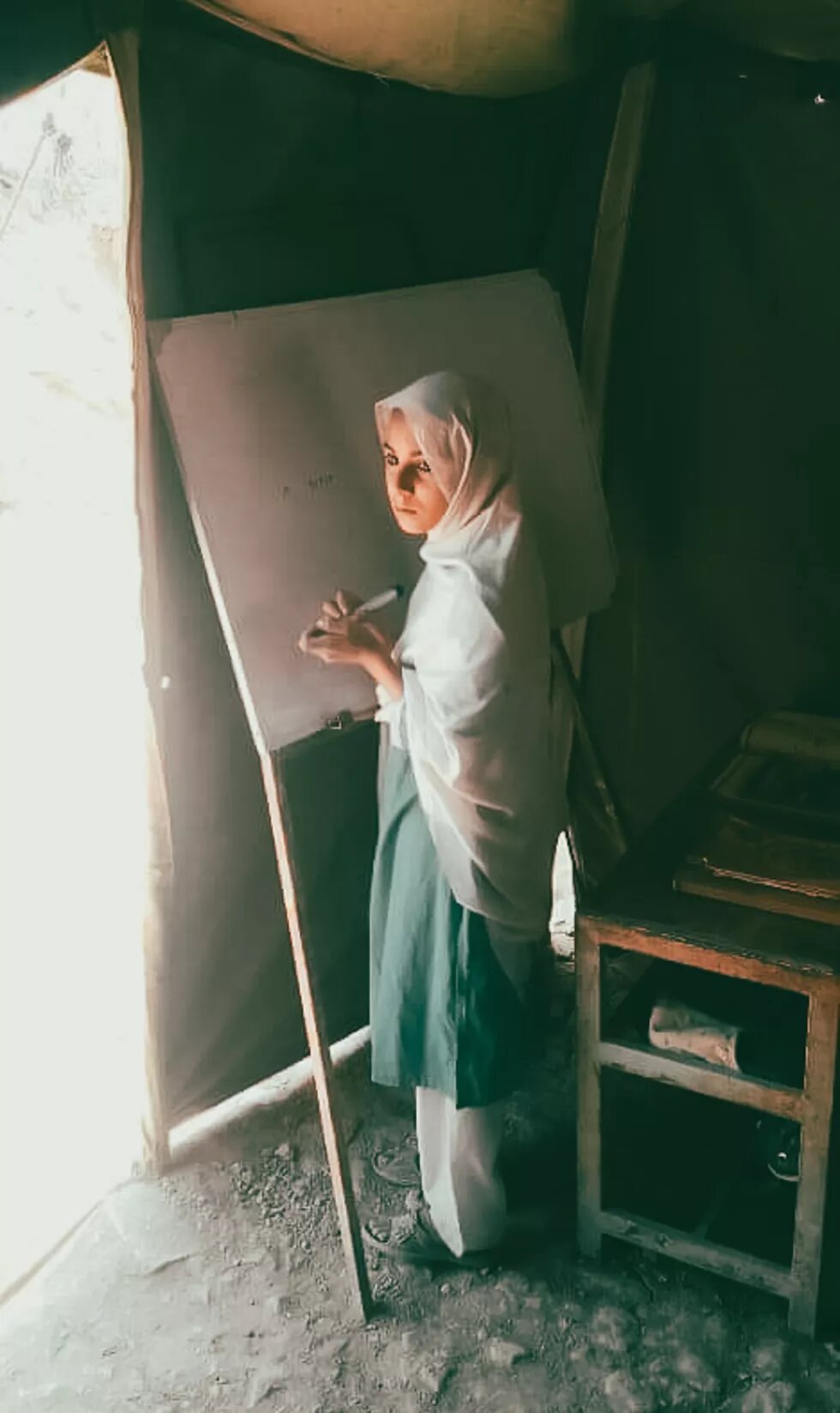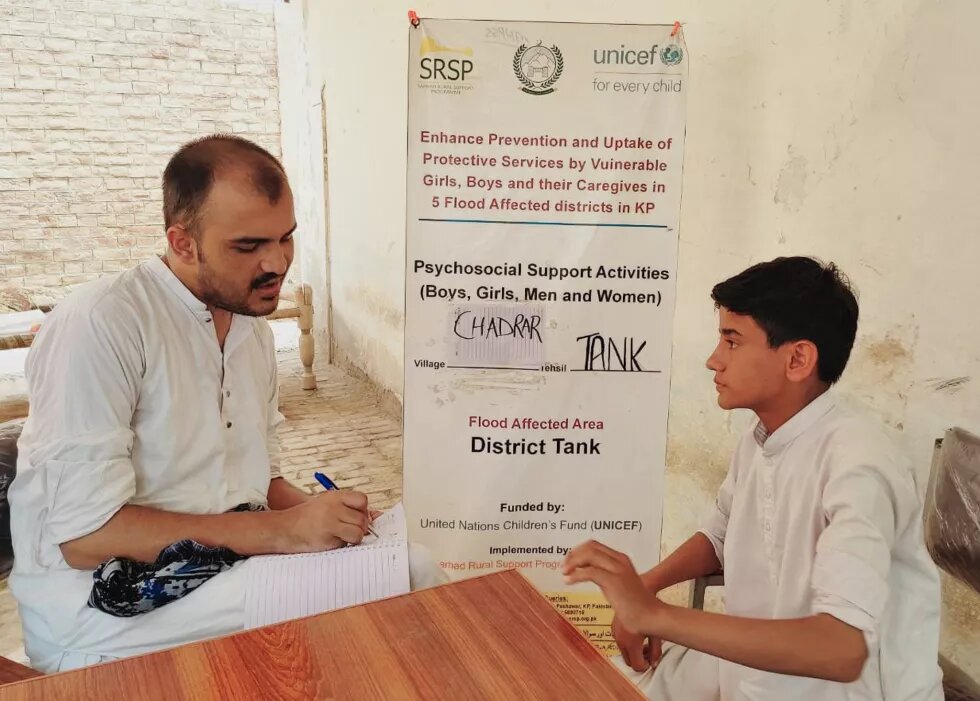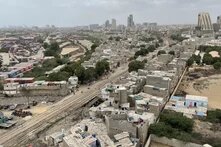
As climate induced disasters damage educational infrastructures in Pakistan, the country struggles to bring millions of out of school children back to schools.

Shaheen Bibi, a Class 2 student in a government school at Daraban in Dera Ismail Khan district of Pakistan, had stars in her eyes. The bubbly girl would always say she dreamt of becoming a doctor. But after the devastating climate change induced floods in 2022 completely damaged her school, a stoic silence envelopes her face.
According to Ejaz Hussain, Shaheen Bibi’s teacher, mud filled gushing water destroyed the school building interrupting the studies of children like her. “The disaster has left them in trauma. They are in a state of fear and experiencing bouts of phobia,” said Hussain.
Ejaz said that he had 125 students in his class, out of them 35 had stopped attending the school after the destruction caused by floods. Among the 90 students who are coming to the school, many would soon drop out because their families would shift to safer locations. “Due to lack of basic facilities like furniture, drinking water and even toilets in temporary learning arrangements, a number of parents are reluctant to send their children, especially girls, to the school,” Ejaz said.
Daraban is a tehsil of Dera Ismail Khan – also known as D.I. Khan – district located at the foothills of Koh-e-Sulaiman mountain range. At least 29 schools in Daraban and 350 schools in the whole district were fully damaged due to flash floods and hill torrents caused by incessant rains. In fact, according to official estimates, thousands of schools across Pakistan were affected by the unprecedented rains for several weeks that were termed by UN chief António Guterres as “monsoon on steroids”.
Devastating impact on education sector
“The catastrophic floods that inundated one-third of the country and affected more than 33 million people have impacted approximately 17,205 educational institutions in the country,” estimates the Ministry of Planning and Development in its Post Disaster Need Assessment (PDNA) report . At least 6,225 educational institutions were assessed as fully damaged and 10,980 as partially damaged, affecting the education of 2.6 million already enrolled students of which over a million are estimated to be female, the report added. Data compiled by the Malala Fund Education Champion Network through rapid response research show that the 2022 floods in Pakistan have disrupted education learning of around 3.5 million enrolled children. Education departments of four provinces however estimated that a total of 30,843 schools – 19,808 in Sindh, 7,439 in Balochistan, 2,096 in Southern Punjab and 1,500 in Khyber Pakhtunkhwa – were damaged in the rain and floods. School education, pre-primary to higher secondary, suffered the most, with a 97 per cent share of all damaged education institutions affecting an estimated 2.4 million students.
Need for climate resilient educational infrastructure
Qamar Naseem, national co-convener of the Pakistan Education Champion Network, a coalition of Pakistan based non-governmental organisations that advocate for girls’ right to at least 12 years of free, quality and equitable education across the country, is of the view that considering the severity of destruction caused by climate induced disasters, it is time for the planning sector of the country to focus on construction of climate resilient educational infrastructure to ensure continuation of education of millions of students in case of natural calamities.
As a first step towards it, Naseem suggests, there should be a vulnerability assessment of all school buildings to identify those schools, which are most vulnerable to earthquakes and floods. “This information should be used to prioritize retrofits and new construction through a long-term mitigation plan. Future planning should include a programme of co-management of facility maintenance, cleaning and improvements by parents, students and communities to promote a culture of care for physical infrastructure,” he said, adding that the dismal condition of education, especially girls’ education, in Pakistan needs urgent measures on war footing to overcome all handicaps.
To illustrate his point, Naseem cites the figures of the Pakistan Education Statistics 2016-17 launched by the Academy of Educational Planning and Management that said that Pakistan had about 22.84 million out of school children – 44 per cent boys and 56 per cent girls – which is the second highest in the world. “The damage to 17,205 schools and subsequent disruption of studies of an additional 3.5 million already enrolled as students due to floods has further complicated the situation,” he said.
Severe blow to girls’ education
In Khyber Pakhtunkhwa province, there were a staggering 4.7 million out of school children aged between five and 16 years before the devastating floods. That included 2.9 million girls. “Now, the situation has become worse with the damage of 1,888 schools due to the 2022 floods,” said Noor Alam Khan, senior planning officer of the elementary and secondary education department of the province.
According to Khan, the floods have dealt a severe blow to school infrastructure in Khyber Pakhtunkhwa where the government had not yet fully recovered from the damages inflicted by super floods of 2010 even after spending billions of rupees. The province had also suffered damages to 3,300 schools due to the disastrous earthquake of 2005. Besides, in the decade-long militancy in the region from 2007 to 2017, terrorists blew up more than 1,000 schools because they were against girls’ education. Out of the schools damaged by terrorists, 400 are being constructed while 750 schools damaged by earthquake are still awaiting reconstruction.
After the disaster of 2022 floods, an estimated cost of Rs. 8,394.20 million (US$ 27.9 million) have been earmarked to rehabilitate or reconstruct 532 fully and partially damaged schools – 327 for boys and 205 for girls. “The remaining 118 fully and 1,238 partially damaged schools not covered under any plan as yet need immediate reconstruction/ rehabilitation for which approximately Rs. 6,514 million (US$ 217 million) are required,” Khan said.
Funds for reconstruction of damaged schools in the wake of climate induced disasters, calamities or terrorist attacks are mostly arranged by the government through its own resources and collection of donations from international organisations including United Nations Development Programme, Japan International Cooperation Agency, Asian Development Bank and United Nations Children’s Fund.
According to Khan, despite limited resources, the Khyber Pakhtunkhwa government has spent a colossal amount of Rs.30 billion (US$ 1,000 million) on its own and and assistance from international donors from 2011 to 2019 to make facilities in schools better but still a lot of work is required to make all the schools properly functional.
Connection between girls’ education and child marriage
“The relationship between girls’ education and early child marriages is very strong so dropping of a large number of girls from schools would have a very negative impact not only on education but on their whole lives,” said Sana Ahmad, programme coordinator of Blue Veins, a Khyber Pakhtunkhwa based NGO working towards empowering women and transgender persons.
Sana, who has co-authored a qualitative analysis of the relationship between girls’ education and early, child and forced marriages, said that due to shortage of around 15,000 schools for ensuring access of all children to education in the province, around 60 per cent of the girls could not reach to the middle from primary level while only 18 to 19 per cent of the girls could reach up to Class 10.
Similarly, in merged areas, formerly tribal regions of Pakistan, 74.4 per cent of the total 1.01 million out of school children are girls due to large scale bombing of their schools by terrorists.
“Our research finds out that school dropout and child marriages as interrelated outcomes that have an enormous impact on adolescent girls while education has the potential to act as an antidote to child marriage. It has been observed that girls who are enrolled in the education system are more likely to marry later,” she added.
Psychological counselling for emotional recovery of children
Realizing the effects of post-traumatic stress disorder (PTSD) on children as well as teachers after the devastating floods, Sarhad Rural Support Programme (SRSP), a non-profit organization working towards community empowerment, started psychological counselling sessions in five flood affected districts. According to Sultan Mehmood, SRSP’s project director (child protection), teachers are trained by psychologists during the sessions on how they can while taking classes help the children overcome their fear.
The SRSP is working on the psychological wellbeing of distressed children and teachers in selected districts badly impacted by the floods and providing other support with the cooperation of the education department. “People are informed about the counselling sessions in their respective areas through announcements from loudspeakers and intimations to children at school level by meeting with administration. We have set a target of providing counseling to 12,000 children and around 5,000 students so that they benefit from the initiative and recover from trauma,” Mehmood said.
Spike in child labour, begging in wake of flood devastation
Civil society organisations (CSOs) are concerned that Pakistan has registered an alarming spike in child labour and begging after the damage to its economy by floods and subsequent inflation and loss of jobs. There is no official survey to substantiate the concerns but according to Imran Takkar, project coordinator of Group Development Pakistan, a CSO working on protecting and promoting child rights, the assessment has been made on the basis of feedbacks from commercial areas and work places where a lot of children are seen working in different workshops, restaurants and shops, and also begging.
“Financial woes in the wake of devastation and damage wreaked by floods have badly impacted child health and education. Efforts by government institutions and CSOs to bring street children back to schools have met with failure because the poverty stricken parents send them back for work and begging to generate earning and support families. The situation is so bad that even expecting mothers are not getting proper nutrition and shortage of food is impacting them physically and mentally,” Takker said.
Alternate source of learning
According to Iqbal Khan, director of Khyber Pakhtunkhwa education department, apart from reconstruction of damaged buildings, the government is also utilizing non-formal sources of learning like community based schools (CBS), accelerated learning programme (ALP) centres and TLCs to impart education to children.
“We have around 1,378 ALP centres in Khyber Pakhtunkhwa while there are 46,018 students at CBS. More CBS are opened to accommodate children whose schools are fully damaged,” Iqbal Khan said.
The federal government has recently chalked out a national action plan of bringing three million out of school students back to school. The mega strategy will soon be implemented on war footings after combating the prevailing financial crunch faced by the country. Pakistan is also seeking financial assistance from the UN and other international organisations to overcome losses wreaked by devastating climate induced floods on the educational sector in the country.
Sindh was the worst affected province during the 2022 floods. Around two million students dropped out of schools as the flood water stagnated in large areas for several months. Partab Shivani of Thar Education Alliance said that the flood affected 17,000 schools in Sindh out of which 6,000 were completely destroyed.
He appreciated the decision of the Sindh government to appoint 60,000 teachers in the province, which, he said, would overcome the problem of teachers’ shortage. He said the civil society is extending full support to the government in achieving its target of bringing back all the two million out of school children and temporary schools have been set up in different locations to achieve the target.
CSOs’ response in recovering education losses
Apart from the government, different CSOs and humanitarian organizations also came forward to recover the losses inflicted by floods on the education system in Pakistan. UNICEF established more than 500 TLCs in the worst-affected districts and supported teachers and children with education supplies. To support children’s mental and physical health, UNICEF is training the teachers on psycho-social care and health screenings, and is preparing for back-to-school and enrollment activities for those schools that have been cleaned and rehabilitated, according to information shared on its website.
“We are deeply concerned about the worrisome disruption of educational activities after floods had destroyed thousands of schools across the country,” said Shoaib Hashmi, communication officer at Al-Khidmat Foundation, one of Pakistan’ s leading charity organizations.
As an immediate response, Al-Khidmat set up 17 TLCs at tent villages across the country to help thousands of students resume academic activities. The organization has also started work on “Schools Reconstruction and & Repair Projects” across the country – 35 in Sindh, 20 in Khyber Pakhtunkhwa, 18 in Southern Punjab and 25 in Balochistan.
Pakistan Education Champion Network (PECN) in collaboration with Blue Veins has launched “Rise and Shine Girls’ Education Leadership Network” to empower and strengthen girls' leadership to champion the issue of girls’ education and enable girls’ voice to articulate concerns related to education at relevant forums and raise voices for furthering a movement on girls' access to quality education.
Flood rehabilitation, mitigating measures
Since Pakistan is witnessing massive devastation and destruction due to disasters caused by climatic changes, experts are suggesting incorporation of mitigation measures in policies by the Planning and Development Department of Pakistan.
Noor Alam Khan suggests that in future construction of any educational institution in the country should be made conditional with prior approval or certification from the National and Provincial Disaster Management Authorities. “All new school and college buildings must be established at sites that are not prone to damage and destruction in case of disaster,” Noor Alam Khan said.
Qamar Naseem, on the other hand, is in favour of replicating the public-private policy in all provinces introduced by the Sindh government for the provision of education to students.
The Khyber Pakhtunkhwa government is spending around Rs.18,000 (US$ 60.2) on every primary student annually and Rs.48,000 (US$ 160.5) on the students of secondary level. “If an agreement is reached with private educational institutions for the studies of out of school children, about a half of this amount can be saved and children will also get education without the construction of any new schools,” he said.











